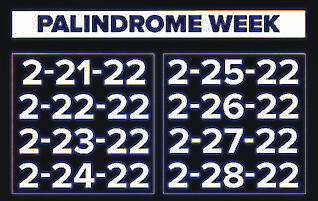
SIDNEY — This Monday, 2-28-22, marks the end of “Palindrome Week 2022,” where the highlight, 2-22-22, took center stage.
Palindrome week 2022 includes 2-21-22, 2-22-22, 2-23-22, 2-24-22, 2-25-22, 2-26-22, 2-27-22, and 2-28-22.
What is a palindrome, and who cares?
A palindrome is a series of letters or numbers that read the same backwards and forwards.
Ascribing the significance to patterns of numbers to real-life events is a pseudoscience called numerology, which ranks alongside astrology, for fun but meaningless interpretations to one’s future marital potential, career prospects, or impending fortunes or misfortunes.
Recently, the popular word game Wordle, and its numerical equivalent, Nerdle, have become especially popular. So, these game aficionados, are likely to be particularly sensitive to noticing and figuring out patterns in alpha or numeric combinations.
While there are a variety of interesting mathematical puzzles, some of the more serious applications in history involving the study of the ordering of numbers and letters, and various combinations thereof, have been in the science of cryptography.
Palindromes and the ability to view the world of printed letters and numbers from several angles has become more than a fascination, but an applicable skill with practical value. Going back to the Old Testament days, a process called gematria ascribed religious interpretations to numerical patterns in biblical passages. Later, a variety of techniques in coded messages sent by criminals and aristocracy alike found real-world value as a means by which to covertly communicate. Later, wider use of cryptographic techniques would be adopted by the military and evolved into what we know today as encryption, the techniques that keep everything from online bank transactions to text messages to lovers private.
For those interested in reading a history of cryptography, The Code Book by Simon Singh is an excellent primer. I had the opportunity to attend several talks by Singh while in Cambridge, England, when he was demonstrating the Enigma machine, as well as during a conference Turing Centenary conference that same year and spoke to him briefly when he signed my copy of The Code Book.
Some of the techniques, like frequency analysis, can even come in handy to improve Wordle scores. (Contestants on the television show Wheel of Fortune also used this technique when they figured out RSTLNE were some of the most common letters in English words). Using this strategy, for example, I started out well in my first two attempts at Wordle.
Mirror writing takes reading palindromic dates to the next level: that is, the ability to write entire sentences, paragraphs, or even books in a backwards fashion, either in cursive or print handwriting, so that if held up to a mirror, the writing looks normal.
While it might be possible to use a mirror to ‘cheat’ one’s way to becoming a mirror writer, natural mirror writers do not do this.
Some people have a knack for being able to read and write backwards and forwards. Perhaps the most famous was Leonardo da Vinci, who used mirror writing, an early cryptographic technique, to write down ideas for new inventions in his notebooks.
I happen to be one of these people who can mirror write, and I made a short video demonstrating mirror writing on YouTube using a passage from Singh’s Code Book.
When I mirror write, I visualize the letters either in print or cursive backwards in my mind as backwards individual letters coming together to form words, then write what I see on paper. The skill has no real practical value today, so I rarely use it except as a matter of curiosity, and, inspired by da Vinci, I kept a personal journal written this way.
The interesting takeaway from Palindrome Week is to appreciate the variety of perspectives from which we can see the same information, teaching us, perhaps, to develop more tolerance for a variety of opinions that reflect our world from seeing it in different but equally valid ways.


